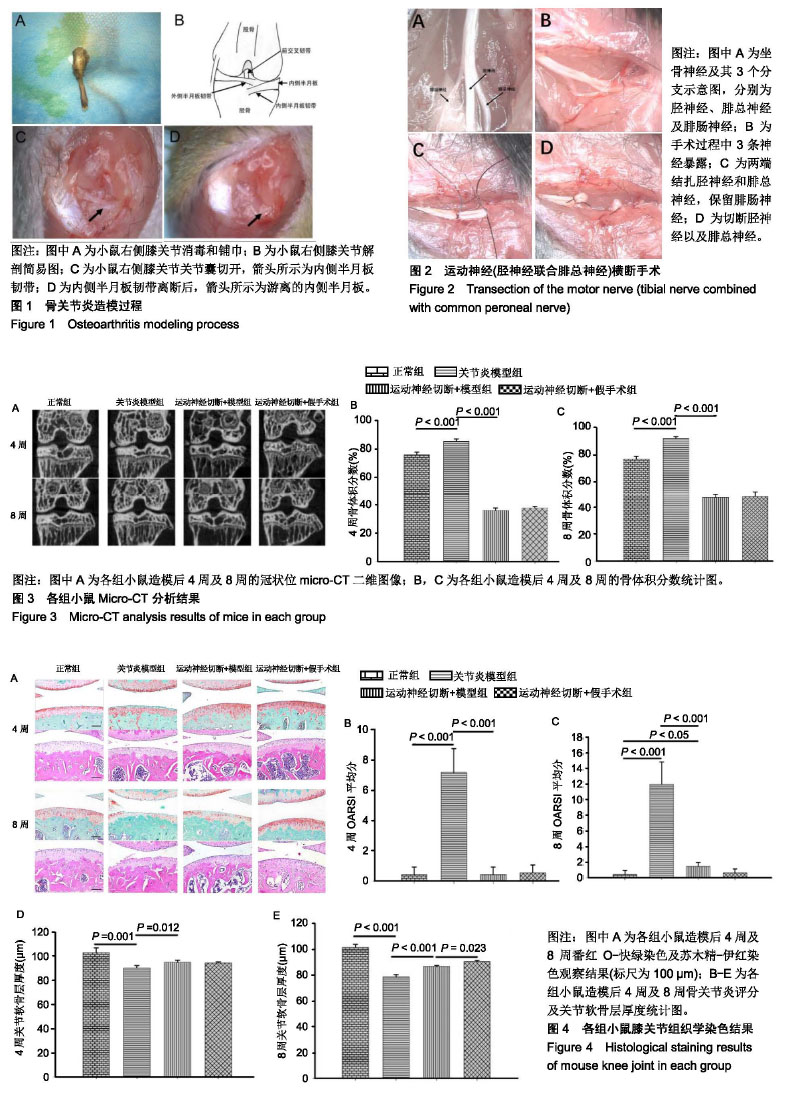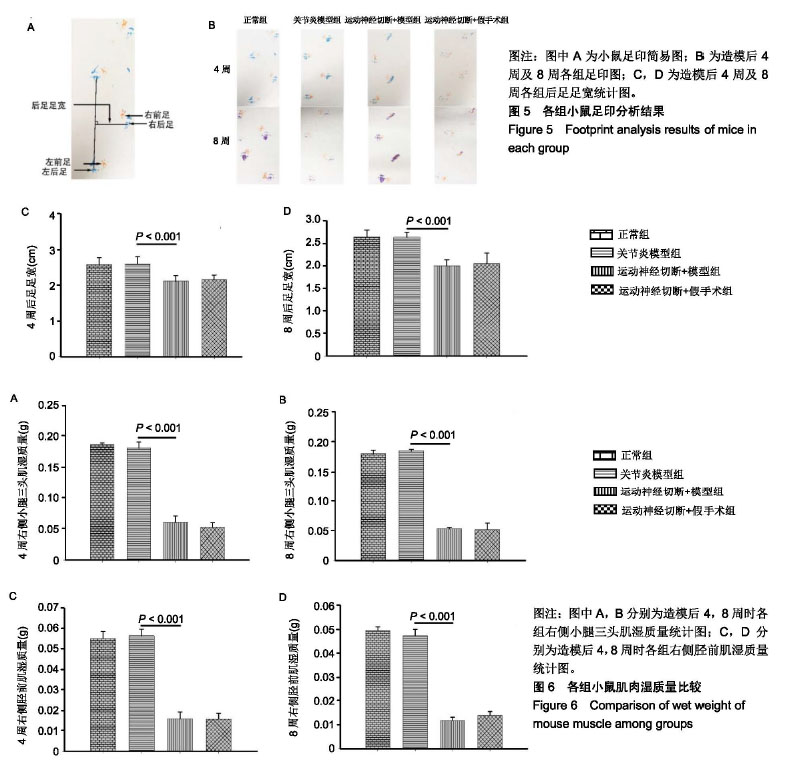| [1]Hootman JM, Helmick CG. Projections of US prevalence of arthritis and associated activity limitations. Arthritis Rheum. 2006;54(1):226-229.[2]Loeser RF, Goldring SR, Scanzello CR, et al. Osteoarthritis: a disease of the joint as an organ. Arthritis Rheum. 2012;64(6): 1697-1707.[3]Felson DT. Epidemiology of hip and knee osteoarthritis. Epidemiol Rev. 1988;10:1-28.[4]Moyer RF, Ratneswaran A, Beier F, et al. Osteoarthritis year in review 2014: mechanics--basic and clinical studies in osteoarthritis. Osteoarthritis Cartilage. 2014;22(12):1989-2002.[5]Nomura M, Sakitani N, Iwasawa H, et al. Thinning of articular cartilage after joint unloading or immobilization. An experimental investigation of the pathogenesis in mice. Osteoarthritis Cartilage. 2017;25(5):727-736.[6]Cucchiarini M, de Girolamo L, Filardo G, et al. Basic science of osteoarthritis. J Exp Orthop. 2016;3(1):22.[7]Madry H, Luyten FP, Facchini A. Biological aspects of early osteoarthritis. Knee Surg Sports Traumatol Arthrosc. 2012; 20(3):407-422.[8]Bleuel J, Zaucke F, Brüggemann GP, et al. Effects of cyclic tensile strain on chondrocyte metabolism: a systematic review. PLoS One. 2015;10(3):e0119816.[9]Silverwood V, Blagojevic-Bucknall M, Jinks C, et al. Current evidence on risk factors for knee osteoarthritis in older adults: a systematic review and meta-analysis. Osteoarthritis Cartilage. 2015;23(4):507-515.[10]Bader DL, Salter DM, Chowdhury TT. Biomechanical influence of cartilage homeostasis in health and disease. Arthritis. 2011; 2011:979032.[11]Jurvelin J, Kiviranta I, Tammi M, et al. Softening of canine articular cartilage after immobilization of the knee joint. Clin Orthop Relat Res. 1986;(207):246-252.[12]Hinterwimmer S, Krammer M, Krötz M, et al. Cartilage atrophy in the knees of patients after seven weeks of partial load bearing. Arthritis Rheum. 2004;50(8):2516-2520.[13]Kim H, Iwasaki K, Miyake T, et al. Changes in bone turnover markers during 14-day 6 degrees head-down bed rest. J Bone Miner Metab. 2003;21(5):311-315.[14]Lang TF, Leblanc AD, Evans HJ, et al. Adaptation of the proximal femur to skeletal reloading after long-duration spaceflight. J Bone Miner Res. 2006;21(8):1224-1230.[15]Bloomfield SA, Allen MR, Hogan HA, et al. Site- and compartment-specific changes in bone with hindlimb unloading in mature adult rats. Bone. 2002;31(1):149-157.[16]Stevens HY, Meays DR, Frangos JA. Pressure gradients and transport in the murine femur upon hindlimb suspension. Bone. 2006;39(3):565-572.[17]Hanson AM, Ferguson VL, Simske SJ, et al. Comparison of tail-suspension and sciatic nerve crush on the musculoskeletal system in young-adult mice. Biomed Sci Instrum. 2005;41:92-96.[18]Malagelada F, Vega J, Guelfi M, et al. Anatomic lectures on structures at risk prior to cadaveric courses reduce injury to the superficial peroneal nerve, the commonest complication in ankle arthroscopy. Knee Surg Sports Traumatol Arthrosc. 2019 Feb 7. doi: 10.1007/s00167-019-05373-x. [Epub ahead of print][19]Guled U, Gopinathan NR, Goni VG, et al. Proximal tibial and fibular physeal fracture causing popliteal artery injury and peroneal nerve injury: A case report and review of literature. Chin J Traumatol. 2015;18(4):238-240.[20]Geyik S, Geyik M, Yigiter R, et al. Preventing Sciatic Nerve Injury due to Intramuscular Injection: Ten-Year Single-Center Experience and Literature Review. Turk Neurosurg. 2017;27(4): 636-640.[21]Zhang Q, Chen H, Liu G, et al. Comparison of healing results between tibial nerve and common peroneal nerve after sciatic nerve injury repair in rhesus monkey. Zhongguo Xiu Fu Chong Jian Wai Ke Za Zhi. 2016;30(5):608-611.[22]Glasson SS, Blanchet TJ, Morris EA. The surgical destabilization of the medial meniscus (DMM) model of osteoarthritis in the 129/SvEv mouse. Osteoarthritis Cartilage. 2007;15(9):1061-1069.[23]Cichon J, Sun L, Yang G. Spared Nerve Injury Model of Neuropathic Pain in Mice. Bio Protoc. 2018;8(6): e2777.[24]Nakasa T, Ishikawa M, Takada T, et al. Attenuation of cartilage degeneration by calcitonin gene-related paptide receptor antagonist via inhibition of subchondral bone sclerosis in osteoarthritis mice. J Orthop Res. 2016;34(7):1177-1184.[25]Iijima H, Aoyama T, Ito A, et al. Exercise intervention increases expression of bone morphogenetic proteins and prevents the progression of cartilage-subchondral bone lesions in a post-traumatic rat knee model. Osteoarthritis Cartilage. 2016; 24(6):1092-1102.[26]Ma M, Basso DM, Walters P, et al. Behavioral and histological outcomes following graded spinal cord contusion injury in the C57Bl/6 mouse. Exp Neurol. 2001;169(2):239-254.[27]Anderson MJ, Diko S, Baehr LM, et al. Contribution of mechanical unloading to trabecular bone loss following non-invasive knee injury in mice. J Orthop Res. 2016;34(10): 1680-1687.[28]Poulet B. Non-invasive Loading Model of Murine Osteoarthritis. Curr Rheumatol Rep. 2016;18(7):40.[29]Kuyinu EL, Narayanan G, Nair LS, et al. Animal models of osteoarthritis: classification, update, and measurement of outcomes. J Orthop Surg Res. 2016;11:19.[30]Little CB, Hunter DJ. Post-traumatic osteoarthritis: from mouse models to clinical trials. Nat Rev Rheumatol. 2013;9(8): 485-497.[31]Thysen S, Luyten FP, Lories RJ. Targets, models and challenges in osteoarthritis research. Dis Model Mech. 2015;8(1):17-30.[32]Iijima H, Aoyama T, Ito A, et al. Effects of short-term gentle treadmill walking on subchondral bone in a rat model of instability-induced osteoarthritis. Osteoarthritis Cartilage. 2015;23(9):1563-1574.[33]Iijima H, Aoyama T, Ito A, et al. Destabilization of the medial meniscus leads to subchondral bone defects and site-specific cartilage degeneration in an experimental rat model. Osteoarthritis Cartilage. 2014;22(7):1036-1043.[34]Fang H, Huang L, Welch I, et al. Early Changes of Articular Cartilage and Subchondral Bone in The DMM Mouse Model of Osteoarthritis. Sci Rep. 2018;8(1):2855.[35]Lin C, Shao Y, Zeng C, et al. Blocking PI3K/AKT signaling inhibits bone sclerosis in subchondral bone and attenuates post-traumatic osteoarthritis. J Cell Physiol. 2018;233(8):6135-6147.[36]Khorasani MS, Diko S, Hsia AW, et al. Effect of alendronate on post-traumatic osteoarthritis induced by anterior cruciate ligament rupture in mice. Arthritis Res Ther. 2015;17:30.[37]Madry H, van Dijk CN, Mueller-Gerbl M. The basic science of the subchondral bone. Knee Surg Sports Traumatol Arthrosc. 2010;18(4):419-433.[38]Iwamoto J, Matsumoto H, Takeda T, et al. Effects of vitamin K2 on cortical and cancellous bone mass, cortical osteocyte and lacunar system, and porosity in sciatic neurectomized rats. Calcif Tissue Int. 2010;87(3):254-262.[39]Kingery WS, Offley SC, Guo TZ, et al. A substance P receptor (NK1) antagonist enhances the widespread osteoporotic effects of sciatic nerve section. Bone. 2003;33(6):927-936.[40]Rehan Youssef A, Longino D, Seerattan R, et al. Muscle weakness causes joint degeneration in rabbits. Osteoarthritis Cartilage. 2009;17(9):1228-1235.[41]Herzog W, Longino D, Clark A. The role of muscles in joint adaptation and degeneration. Langenbecks Arch Surg. 2003; 388(5):305-315.[42]Herzog W, Longino D. The role of muscles in joint degeneration and osteoarthritis. J Biomech. 2007;40 Suppl 1:S54-63.[43]Karamanidis K, Oberländer KD, Niehoff A, et al. Effect of exercise-induced enhancement of the leg-extensor muscle-tendon unit capacities on ambulatory mechanics and knee osteoarthritis markers in the elderly. PLoS One. 2014;9(6): e99330.[44]van der Poel C, Levinger P, Tonkin BA, et al. Impaired muscle function in a mouse surgical model of post-traumatic osteoarthritis. Osteoarthritis Cartilage. 2016;24(6):1047-1053.[45]Kim H, Wrann CD, Jedrychowski M, et al. Irisin Mediates Effects on Bone and Fat via αV Integrin Receptors. Cell. 2018; 175(7):1756-1768.e17.[46]Chen H, Hu B, Lv X, et al. Prostaglandin E2 mediates sensory nerve regulation of bone homeostasis. Nat Commun. 2019; 10(1):181.[47]Mapp PI, Walsh DA. Mechanisms and targets of angiogenesis and nerve growth in osteoarthritis. Nat Rev Rheumatol. 2012; 8(7):390-398. |
.jpg) 文题释义:
膝关节应力负荷:正常膝关节维持软骨的生理稳态依赖于合适的膝关节应力负荷,应力负荷被认为是骨骼肌肉组织的调节器,过大或过小的应力负荷都会对关节软骨和软骨下骨产生不利影响。
骨关节炎:是目前全世界患病率较高的慢性进展性疾病,影响主要的负重关节(如髋关节、膝关节),引起关节软骨退变、软骨下骨重塑、滑膜炎症及骨赘形成。最新研究表明,机械应力在骨关节炎的发病进展中起着重要的作用。正常的关节负荷以及活动所产生的适度机械应力有助于维持关节软骨的合成及分解代谢。过度的关节负荷会引起软骨细胞的分解代谢增加,导致软骨的软化、纤维化及溃疡形成,最终导致软骨丢失,引起骨性关节炎。
文题释义:
膝关节应力负荷:正常膝关节维持软骨的生理稳态依赖于合适的膝关节应力负荷,应力负荷被认为是骨骼肌肉组织的调节器,过大或过小的应力负荷都会对关节软骨和软骨下骨产生不利影响。
骨关节炎:是目前全世界患病率较高的慢性进展性疾病,影响主要的负重关节(如髋关节、膝关节),引起关节软骨退变、软骨下骨重塑、滑膜炎症及骨赘形成。最新研究表明,机械应力在骨关节炎的发病进展中起着重要的作用。正常的关节负荷以及活动所产生的适度机械应力有助于维持关节软骨的合成及分解代谢。过度的关节负荷会引起软骨细胞的分解代谢增加,导致软骨的软化、纤维化及溃疡形成,最终导致软骨丢失,引起骨性关节炎。.jpg) 文题释义:
膝关节应力负荷:正常膝关节维持软骨的生理稳态依赖于合适的膝关节应力负荷,应力负荷被认为是骨骼肌肉组织的调节器,过大或过小的应力负荷都会对关节软骨和软骨下骨产生不利影响。
骨关节炎:是目前全世界患病率较高的慢性进展性疾病,影响主要的负重关节(如髋关节、膝关节),引起关节软骨退变、软骨下骨重塑、滑膜炎症及骨赘形成。最新研究表明,机械应力在骨关节炎的发病进展中起着重要的作用。正常的关节负荷以及活动所产生的适度机械应力有助于维持关节软骨的合成及分解代谢。过度的关节负荷会引起软骨细胞的分解代谢增加,导致软骨的软化、纤维化及溃疡形成,最终导致软骨丢失,引起骨性关节炎。
文题释义:
膝关节应力负荷:正常膝关节维持软骨的生理稳态依赖于合适的膝关节应力负荷,应力负荷被认为是骨骼肌肉组织的调节器,过大或过小的应力负荷都会对关节软骨和软骨下骨产生不利影响。
骨关节炎:是目前全世界患病率较高的慢性进展性疾病,影响主要的负重关节(如髋关节、膝关节),引起关节软骨退变、软骨下骨重塑、滑膜炎症及骨赘形成。最新研究表明,机械应力在骨关节炎的发病进展中起着重要的作用。正常的关节负荷以及活动所产生的适度机械应力有助于维持关节软骨的合成及分解代谢。过度的关节负荷会引起软骨细胞的分解代谢增加,导致软骨的软化、纤维化及溃疡形成,最终导致软骨丢失,引起骨性关节炎。

.jpg)
.jpg) 文题释义:
膝关节应力负荷:正常膝关节维持软骨的生理稳态依赖于合适的膝关节应力负荷,应力负荷被认为是骨骼肌肉组织的调节器,过大或过小的应力负荷都会对关节软骨和软骨下骨产生不利影响。
骨关节炎:是目前全世界患病率较高的慢性进展性疾病,影响主要的负重关节(如髋关节、膝关节),引起关节软骨退变、软骨下骨重塑、滑膜炎症及骨赘形成。最新研究表明,机械应力在骨关节炎的发病进展中起着重要的作用。正常的关节负荷以及活动所产生的适度机械应力有助于维持关节软骨的合成及分解代谢。过度的关节负荷会引起软骨细胞的分解代谢增加,导致软骨的软化、纤维化及溃疡形成,最终导致软骨丢失,引起骨性关节炎。
文题释义:
膝关节应力负荷:正常膝关节维持软骨的生理稳态依赖于合适的膝关节应力负荷,应力负荷被认为是骨骼肌肉组织的调节器,过大或过小的应力负荷都会对关节软骨和软骨下骨产生不利影响。
骨关节炎:是目前全世界患病率较高的慢性进展性疾病,影响主要的负重关节(如髋关节、膝关节),引起关节软骨退变、软骨下骨重塑、滑膜炎症及骨赘形成。最新研究表明,机械应力在骨关节炎的发病进展中起着重要的作用。正常的关节负荷以及活动所产生的适度机械应力有助于维持关节软骨的合成及分解代谢。过度的关节负荷会引起软骨细胞的分解代谢增加,导致软骨的软化、纤维化及溃疡形成,最终导致软骨丢失,引起骨性关节炎。